I particularly like the exhibition on Renaissance and Baroque footwear with displays of chopines with insanely high heels! So fascinated I was with the exhibition, I bought the book about the social history of these footwear, written by Senior Curator of the Bata Shoe Museum, Elizabeth Semmelhack, which cost CAN$30.
At the time of our visit, there were four exhibitions. One was on footwear all throughout the ages, then another about socks, and another on native North American footwear and finally the footwear of Renaissance and Baroque.
Alas, I shall let the shoes do the talking this time. :)

Entering the first exhibition hall, All About Shoes: Footwear Through The Ages, which showcases footwear of all ages
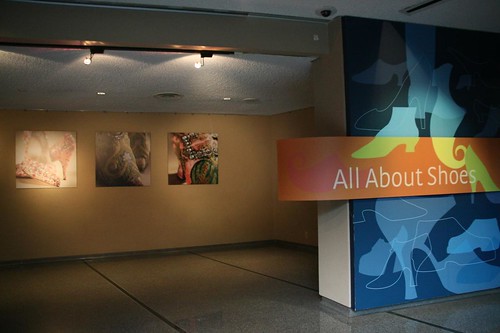
Clever design of using the staircase as shelves for the exhibits

Some of the exhibits from All About Shoes exhibition
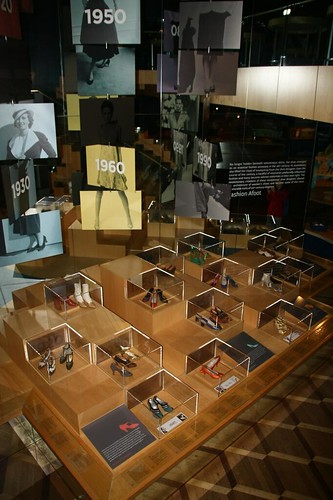
Exhibition hall, Beauty, Identity, Pride: Native North American Footwear

Exhibition hall, On a Pedestal: From Renaissance Chopines to Baroque Heels. Check out the tall stands in the glass display. Those are actually shoes people wore during the Renaissance period! Paintings of both Renaissance and Baroque art were on display as well, showing evidence of the footwear.
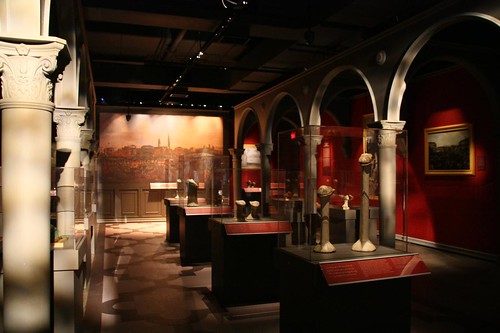
This room showcases mostly different chopines, which came in different heights and form, which I found most intriguing! The oddest shoes I knew before this shoe museum visit were those tiny shoes for Chinese ladies with bound feet. This visit has been extremely educational for me.

An x-ray showing how the nails are driven from the sole into the thick heel of the chopine, to keep them together.

Please click on these pictures below to view a large version.
Turkish bath sandals called Nalins, worn by women to public bath houses during the time of the Ottoman Empire in the 19th century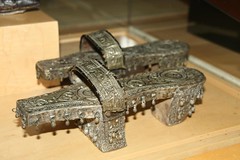 | A pair of paduka with toe knobs are wooden footwear related to Hinduism in India. It also refers to the footprints of deities and saints that are venerated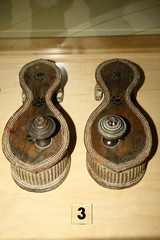 | Kurdaitcha shoes are made from feathers and human hair, and treated with blood. They worn by men who are kurdaitchas (ritual executioners) from the Arrernte people, Australian Aborigines.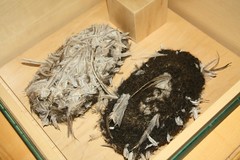 |
Chestnut crushing clog worn to shell chestnuts during the 19th century in the Haute Ardeches, Auvergne region of France.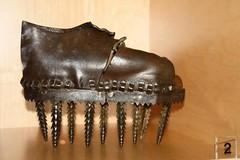 | Fumidawara are special boots made from rice straw and used in northern parts of Japan to clear a path through the snow around the house. | Cow boot worn when cows in Canada injure their legs and are undergoing recuperation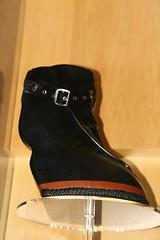 |
Sumo geta are worn by sumo wrestlers. They are carved from a single piece of wood for strong support.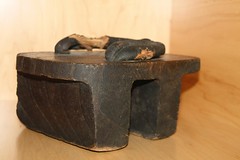 | Oregon boot or Gardner Shackle is a footwear with a heavy metal ring locked around the ankle of a prisoner to prevent him from escaping during transfers.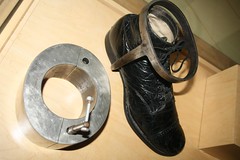 | Heavy leather boots worn by Han women with bound feet who did laborious work |
Hand-knitted and covered with embelishments are these Croatian men's socks from Grlici, worn in the 19th century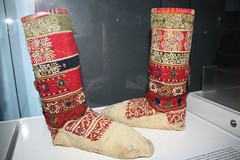 | Leather boot socks from Northern Afghanistan in the late 19th century served as a boot for horseback riding and walking.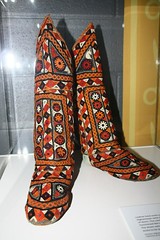 | A layer of grass is placed in the boots to add warmth and keep moisture out. This was practised by many Saami peoples of Norway, Finland, Sweden and Kola Peninsula in the 20th century.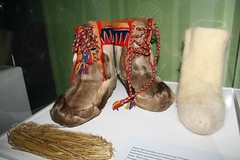 |
Bright colours and daring design of 'car' shoes by Betty Levine in the mid 1960s  | The 5,300 year-old Otzi man found in the Alps in 1991 was wearing this shoe stuffed with grass that served as a sock. Grass help keep moisture away and have been used as either socks or sewn into socks.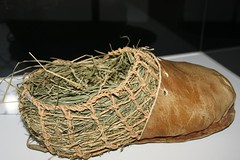 | Socks made from human hair by Anasazi, the ancient Puebloan people in 1200 BC. Human hair was considered to be the most accessible and renewable form of fibre. The Anasazi are famous for their buildings carved and made from stones and other earth materials, that are are called stone and adobe dwellings.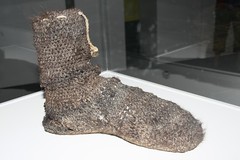 |
Native American boots made from hide leather, some with beadings or paintings of natural elements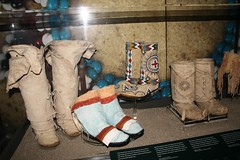 | Boots with water-related symbolism worn by Kachinas of the Zuni tribe. The blue represented water and sky and the red flaps a thirsty tongue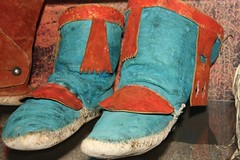 | Caddo moccasins influenced by Delaware and Kickapoo designs 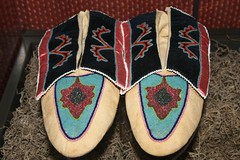 |
Heavily embroidered Huron moccasins. 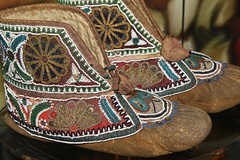 | Early 18th century Iroquois moccasins. Iroquois, Huron and Delaware just reminded me of one of my favourite books, The Last of the Mohicans by James Fenimore Cooper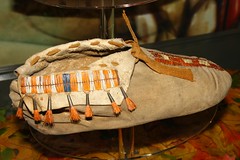 | Chipewyan moose skin moccasins with silk-wrapped horse hair bands in different colours and muskrat fur trim 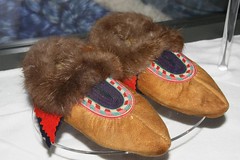 |
Qabaqib sandals worn by woman in Turkish bathhouses during the time of the Ottoman Empire | Italian and velvet-covered chopine with silver lace, silk tassel and tacks, popular in the 16th and 17th century in Europe | Spanish chopine covered in green silk damask with open-toe design, popular in the 16th century |
Italian pontofole or pianelle are low platform mules, worn at home by both men and women, were considered fashionable in the 16th century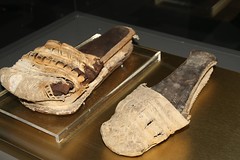 | Wooden Italian 16th century chopine. Chopines are considered expensive due to their height. Not to mention having to extend the length of the wearer's dresses just so that the chopines stay hidden under the dress. Often though, chopines look more expensive than they really cost.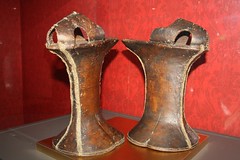 | Chopines were worn to make the ladies look taller and the taller one here is half my height or maybe more!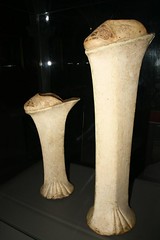 |
Open-toe chopines with a large flare base that is decorated with tacks | Ivory coloured chopines with pretty embroideries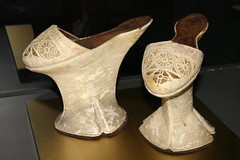 | Red chopines. Chopines were sometimes given to brides as gifts from the groom. Thus, chopines may represent a new social status of a young bride. |
Late 16th century Persian heeled footwear worn by Turkmen or Mongol warriors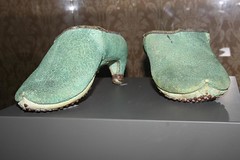 | French heeled shoes with mules of the 17th century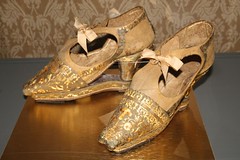 | Swedish jackboots with stacked-leather heels and sharply squared toes of the 17th century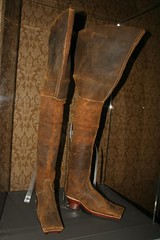 |
Heeled boots worn by upper-class men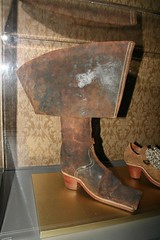 | High-heeled and platform-soled shoes. Shoes with high heels do not necessarily mean they are for women. Women shoes generally have pointed toes and narrow heels. | White children shoes are an expression of status due to their impracticality |
Slap-sole shoes with stacked leather heel painted red to signify social status and privilege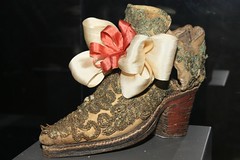 | White slap-sole shoes with pretty embroideries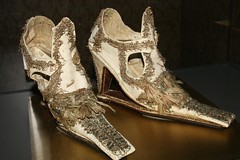 | Elvis Presley's blue patent loafers.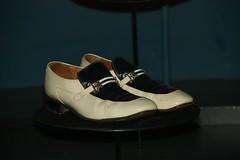 |
1 comment:
Hey Rabbit, awesome post really.
Loved this collection.
Select women shoes for today's fashionista at ShoesAlways: Online Shoe Store for Women.
Post a Comment